
Constellation of the Month: Hydra, Corvus & Crater; The Water Serpent, The Crow & The Cup.
by Mark S Deprest
Printed in Reflections: May, 2001.
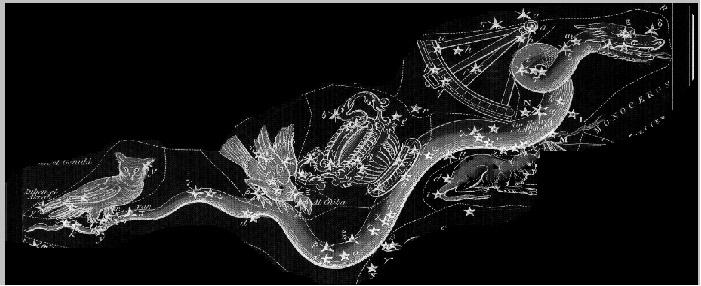
These three constellations are linked in mythology
and are sometimes portrayed as link in the sky. So, we will look at them
together. The story of these three is a delightful one that involves
Apollo
and his wrath and sense of humor.
At one time Corvus, the Crow had beautiful
silver-white plumage and a lovely singing voice, but he lost both of these
as a result of not carrying out Apollo’s orders. It seems that Apollo
sent
Corvus to fetch a cup (Crater) of water. Corvus set out immediately to
complete this task, but along his way he noticed a fig tree, laden with
juicy figs. However, these figs were not quite ripe. Corvus
could not pass
these lovely, juicy figs by and leave them for someone else to devour,
so he decided to wait until they ripened. When the figs had finally
ripened,
he enjoyed his tasty but final meal. When Corvus had eaten all of
the figs
he suddenly remembered his task of fetching water for Apollo. Corvus
quickly
filled the Cup (Crater) and raced back to Apollo, offering a rather lame
excuse that the Water Serpent (Hydra) had hindered his efforts to scoop
up the water. Apollo was young but not that gullible, so Apollo punished
Corvus. For his selfishness, Apollo changed the beautiful silver-white
plumage of Corvus to dirty black. For lying to Apollo, Corvus’ lovely
song
was changed into a raucous screeching caw. The worst punishment by far
was that Apollo placed Corvus and the Cup (Crater) in the sky on the back
of the Water-Serpent (Hydra). Hydra was instructed to make sure that
Corvus
never came within reach of the Cup (Crater) to quench his thirst.
This
Hydra is not the same multi-headed beast that Hercules fought in his second
labor, as this Hydra is always pictured with only one head.
Transit at
Midnight of Alpha Hydra: February 15th
Transit at Midnight of Alpha Crater:
March 13th
Transit at Midnight of Alpha Corvus: March 30th
The constellations
are situated rather low in the sky, (from our point of view
in the northern hemisphere) as only the
head of Hydra rises north 0 degrees Declination. The constellations
Crater
and Corvus are completed south of -6 degrees 30 minutes Declination and
-11 degrees 30 minutes respectively. Hydra, the largest constellation,
stretches across the sky from 8 hours 11.5 minutes at its western border
to 15 hours 2.5 minutes at its eastern edge, and from north 6 degrees 39
minutes declination to south 35 degrees 39.5 minutes declination. Crater
and Corvus are rather small in comparison, occupying about 1 hour of R.
A. each and only 20 degrees and 15 degrees of Dec. respectively.
The main
stars of these three constellations are not very bright, with the exception
of Alpha Hydrae; Alphard, a 1.9 magnitude giant star about 25 times the
size of our sun and about 370 times the luminosity. The rest of the main
stars are 3rd, 4th, and 5th magnitude and because these constellations
ride the southern horizon can be difficult to see if you live in the
northern hemisphere.
Things to Check Out in Hydra, Crater and Corvus:
Multiple Star Systems
Beta Hydrae; HJ4478
- RA (J2000): 11h 52.9m declination -33 54.0’
- Component A: magnitude +4.8
- Component B: magnitude +5.6
- Separation AB: 0.7” at position angle 28
Epsilon Hydrae; STF1273; ADS 6993
- RA (J2000): 08h 46m 46.65s declination: +06 25’ 08.1”
- Visual binary star. Included in Michael R. Feltz’s list of the
widest visual binaries.
- Orbital elements and diagram available on
Richard Dibon-Smith’s website.
- Component A: magnitude +3.8, spectral type G5III
- Component B: magnitude +4.7, spectral type F0V
- Component C: magnitude +7.8, spectral type F7V
- Component D: magnitude +12.7, spectral type K0V
- Separation AC: 2.7” at position angle 302
- The close pair A and B were discovered by Schiaparelli in
1888. Struve discovered star C in 1830.
- Star D shares the
same proper motion.
- Distance: 135 light years.
- Projected orbital separation: 119
AU
- Luminosity (Sun =l): AB 53 C 3 D 0.01
- Diameter (Sun =1): AB ?? C 1.3 D 0.1
N Hydrae; H96, HD100286; ADS 8202
- RA (J2000): 11h 32m 16.42s declination: -29d 15’ 40.9”
- Included in the Astronomical League’s certificate list of 100
double stars.
- Component A: magnitude +5.8, spectral type F8V
- Component B: magnitude +5.9, spectral type F8V
- Separation AB: 9.2” at position angle 210
- First observed by Herschel in 1783.
- It used to be known as
17 Crateris but is clearly within Hydra: Norton’s calls it N
Hydrae.
- Sometimes said to show a yellow tint in both stars.
- Distance: 87 light years
- Projected orbital separation: 245 AU
- Luminosity (Sun =l): A 3 B 2.8
- Diameter (Sun =1): A 1.5 B 1.5
STF1474AB; STF1474AC
- (J2000) RA 10h47.6m Declination -15 16’
- Washington Double Star (WDS) catalog
- Component A: +6.6 magnitude
- Component B: +7.9 magnitude
- Component C: +6.9 magnitude
- Position angle of AB: 26, angular separation 67.4 arcseconds
- Position angle of AC: 25, angular separation 74.1 arcseconds
Gamma Crateris; HJ 840
- (J2000) RA 11h 4.9m Declination -17 41’
- Washington Double Star (WDS) catalog
- Component A: +4.1 magnitude
- Component B: +7.9 magnitude
- Position angle of AB: 94, angular separation: 5.3 arcseconds
Iota Crateris; KUI 58
- (J2000) RA 11h 38.7m Declination -13 12’
- Washington Double Star (WDS) catalog
- Component A: +5.6 magnitude
- Component B: +11.0 magnitude
- Position angle of AB: 226, angular separation: 1.4 arcseconds
Delta
Corvi; Algorab; SHJ145; ADS 8572
- RA (J2000): 12h 29m 51.98s declination:
-16 30’ 54.3”
- Included in the Astronomical League’s certificate list of
100 double stars. Included in the Saguaro Astronomy Club’s list of 110
best multiple stars.
- Components show no relative motion. Components
display common proper motion.
- Component A: magnitude +3.0, spectral type A0V
- Component B: magnitude +9.2, spectral type K2V
- Separation AB: 24.2 ” at position angle 214
- Distance: 88 light-years
- Projected orbital separation: 650 AU
- Luminosity (Sun =1): A 38 B 0.1
- Diameter (Sun =1): A 2.3 B 0.5
STF1669 Corvi; VV
Corvi; ADS 8627
- RA (J2000) 12h 41m 16.02s declination: -13d 00’ 50.1”
- Included
in the Saguaro Astronomy Club’s list of 110 best multiple stars.
- Component
A: magnitude +6.0 spectral type F5V
- Component B: magnitude +6.0, spectral type F5V
- Component C: magnitude +10.5, spectral type ??
- Separation AB: 5” at position angle 309
- Separation AC: 59” at position angle 235
- First observed by Struve in 1828.
- Distance: 278 light-years.
- Projected orbital
separation: AB: 426 AU
- Luminosity (Sun =1): A 24 B 24 C ??
- Diameter (Sun =1): A 3.7 B 3.7 C ??
Burnham 28 Corvi; HD108799; ADS 8573
- RA (J2000): 12h 30m 04.93s declination: -13d 23’ 35.0”
- Visual binary star.
- Included in Michael R. Feltz’s list of the widest visual binaries.
- Orbital diagram available on
Richard Dibon-Smith’s website.
- Component A: magnitude +6.5, spectral type G0V
- Component B: magnitude +8.6, spectral type K
- Separation AB: 2.2” at position angle 329
- First observed by Burnham in 1875.
- Distance: 81 light-years
- Projected orbital separation: 53 AU
- Luminosity (Sun =1): A 1.2 B 0.07
- Diameter (Sun =1): A 1.0 B 0.4
Zeta Corvi; BU 1245
- RA 12h20.6m (J2000) Declination -22 13’
- Washington Double Star (WDS) catalog
- Component A: magnitude +5.2
- Component B: magnitude +13.7
- Position angle of AB: 66, angular separation: 11.2 arcseconds
Deep Sky Objects
M 48; NGC 2548; OCL 584 Open cluster
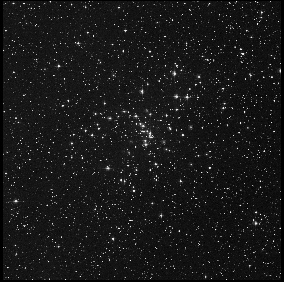
- RA: 08h 13m 43.1s
(J2000) declination: -05d 45’ 02”
- Magnitude: 5.8
- Angular diameter 54.0’
- Cluster, very large, pretty rich in stars, pretty much compressed, stars
of magnitude 9 to 13.
- Messier gave wrong position by 4 deg. in dec.
M 68; NGC 4590; GCL 20; ESO 506-SC30; Globular cluster
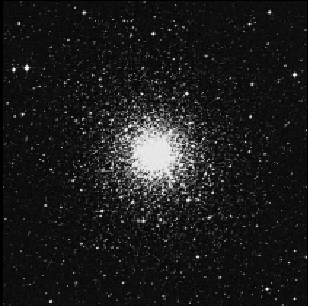
- RA: 12h 39m 28.0s
(J2000) declination: -26d 44’ 34”
- Magnitude: 7.8
- Globular cluster, large,
extremely rich in stars, very compressed, irregular round, resolved, stars
12th mag.
- Angular diameter 12.0’
M 83; NGC 5236; MCG -5-32-50; Spiral Galaxy
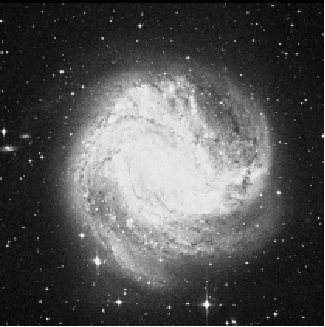
- RA: 13h 37m 00.2s (J2000)
declination: -29s 52’ 04”
- Magnitude: 8.0
- Very much remarkable very bright,
very large, extended 55deg, extremely suddenly brighter middle nucleus,
3- brighter resolvable spiral;
- Angular diameter 11.2’
- Surface brightness 12.8
- Fast supernova producer, 4 in 50 yrs.
- The supernova 1923A was found
in this galaxy on May 5, 1923 at RA 13 34.3, declination -29 37 (epoch
B1950), magnitude 14.0.
- The supernova 1945B was found in this galaxy on
Jul 13, 1945 at RA 13 34.3, declination -29 37 (epochB1950), magnitude
14.2.
- The supernova 1950B was found in this galaxy on Mar 15, 1950 at RA
13 34.3, declination -29 37 (epochB1950), magnitude 14.5.
- The supernova
1957D was found in this galaxy on Dec 1, 1957 at RA 13 34.3, declination
-29 37 (epochB1950), magnitude 15.0.
- The supernova 1968L was found in this
galaxy on Jul 17, 1968 at RA 13 34.3, declination -29 37 (epochB1950),
magnitude 11.9.
- The supernova 1983N was found in this galaxy on Jul 03,
1983 at RA 13 34.3, declination -29 37 (epochB1950), magnitude 12.5.
NGC 5694; Caldwell 66; Globular Cluster
- Right ascension: 14h39m36.8s Declination:
-26 32’ 16”
- Magnitude: +10.2
- Angular diameter 3.6’
- Considerably bright,
considerably small in angular size, round, pretty suddenly brighter middle,
resolvable, star 9.5 south preceding.
NGC 4361; PK67: 294+43; Planetary
Nebula
- J2000 RA: 12h 24.5m dec: -18d 48’
- Magnitude, integrated over entire
object: 10.3. Magnitude of central star: 12.9
- Angular diameter: 80”.
- Very
bright, large, round, very suddenly much brighter middle nucleus, resolvable.
NGC 4038 & NGC 4039; Caldwell 60 & Caldwell 61; Ringtail Galaxy
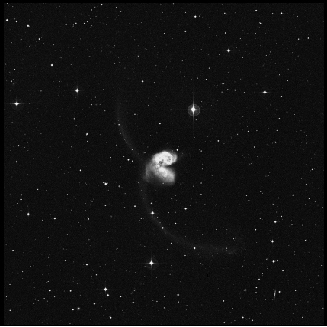
- Right
ascension: 12h01m52.82s Declination: -18 51’ 54.2”
- Magnitude: 10.3
- Pretty
bright, considerably large, round, very gradually brighter middle.
- Ringtail
Galaxy, two filaments.
- Angular diameter 2.6’ x 1’.
- The supernova
1921A
was found in this galaxy on Mar 01, 1921at RA 11 59.3, declination -18
35 (epochB1950), magnitude ??.
NGC 3242; Caldwell 59; PK67: 261+32 1; Ghost of Jupiter; Planetary Nebula
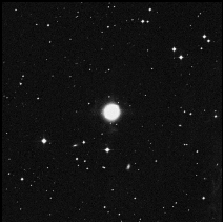
- J2000 RA: 10h 24.8m dec: -18d 38’
- Magnitude: +8.6. Magnitude of central
star: 11.5
- Remarkable planetary nebula, very bright, little extended 147deg,
45” diameter, blue
- Angular diameter 40”x 35”
Credits
All Images on this page were downloaded from the Sloan
Digital Sky Survey.
Links
Copyright Info
Copyright © 2015, the University Lowbrow Astronomers. (The University Lowbrow Astronomers are an amateur astronomy club based in Ann Arbor, Michigan).
This page originally appeared in Reflections of the University Lowbrow Astronomers (the club newsletter).
This page revised Tuesday, April 10, 2018 7:08 PM.
This web server is provided by the University of Michigan;
the University of Michigan does not permit profit making activity
on this web server.
Do you have comments about this page or want more information about the club? Contact Us.







